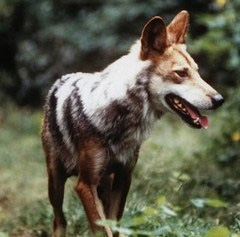
|  |  |  Editorials | Environmental | January 2009 Editorials | Environmental | January 2009  
Wolf Haven Sends Mexican Gray Wolves Home
 Christina Crea - The Chronicle Christina Crea - The Chronicle
go to original


| | A Mexican gray wolf at Wolf Haven outside Tenino, Wash. (Wolf Haven International) |  |
Tenino, Wash. - Six female Mexican gray wolves left Wolf Haven International, located north of Tenino in the Centralia/Chehalis area, on two separate flights to Houston, Texas, late last week and then onto a charter flight to Mexico.

Their final destination is a wolf facility called the Amigos Del Desierto De Coahuila.

"The goal is to breed these genetically rare females at the facility, depending on the needs of the program, in order to augment the population," said Wendy Spencer, animal curator at Wolf Haven, which is open to public visitation.

None of the wolves shipped from Wolf Haven last Tuesday will breed at the facility this year, but most likely several of the females will be recommended for breeding in 2010.

"As for release, it is hoped that some will eventually go out into the wild in Mexico," Spencer said.

Wolf Haven is a nonprofit organization with a mission that states it is "working for wolf conservation" by protecting wild wolves, providing sanctuary for captive-born wolves, promoting wolf restoration in historic ranges and educating the public on the value of all wildlife.

It has also been a participant in the Mexican Wolf Species Survival Plan, a recovery program since 1995, and is one of only three prerelease facilities in the United States.

Since 1982, Wolf Haven has rescued more than 100 captive-born wolves from roadside zoos, animal collectors, private owners, research and other facilities.

Eight of the 10 Mexican gray wolves were born at Wolf Haven, which is why it's crucial that their stay at Wolf Haven includes minimal contact with humans, officials there say.

"Since these animals are managed as hands-off as possible, there has been little that has changed in terms of husbandry as they grew older, other than increasing the amount of food that we feed them," Spencer said.

When it was necessary to catch them for their routine vaccinations and de-wormer, Wolf Haven staff had to change strategies as the wolves matured.

"We were no longer able to just reach in the den and pull them out," Spencer said. "Since some of these wolves will be slated for release, it is critical to their survival in the wild that they do not become habituated to humans."

Mexican gray wolves once roamed throughout vast portions of Arizona, New Mexico, Texas, and Mexico until human settlement intensified across the Southwest in the early 1900s.

In 1976 the species was listed under the Endangered Species Act of 1973, and since then many programs and facilities have worked to bring them back into the wild.

"Because Mexican gray wolves are on loan from the United States Fish and Wildlife Service and held at 48 participating institutions both in the U.S. and Mexico, these animals are moved periodically depending on the recommendation of the Mexican wolf advisory group," Spencer said.

Wolf Haven has already had two Mexican wolf family groups released into the wild in 1998 and 2000.

"These wolves are extremely valuable genetically speaking, so they will serve to augment the population considerably," Spencer said. |

 |
|  |



